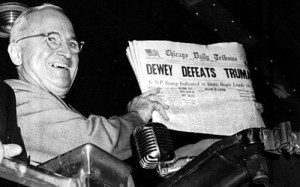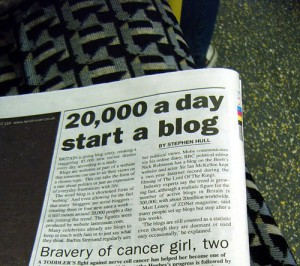
In Part I of this series, we examined aspects of the apparently large gulf between the mainstream media and the emerging media within the context of hockey coverage, specifically involving the often disparate treatment of these factions by various NHL franchises. At the end of the day, however, it all boils down to the message being conveyed, not the identity of the messenger or the vehicle the messenger uses to deliver the content. In this final installment, it is the essence of the message itself that is under the microscope, together with the standards used to govern that content.
As we will see, all participants in this melodrama share distinct culpability for creating an informational environment that is, at best, confusing, and more frequently chaotic. Please note that these are my observations, insights and conclusions. I have spoken with a number of people, on all sides of the issue, and researched I obviously think they have some merit, or I wouldn’t write them. However, I don’t claim the truth as my exclusive territory, and provide these thoughts in hopes of spurring serious thought and debate.
The choice of title – -“Cascading Misinformation” — is not a random selection. Since the early 1990’s , social scientists, economists, legal scholars and others have been studying cascade theory, and its application to human behavior. What is cascade theory? Glad you asked. Here is a simple definition:
Cascade theory explains the observable human behavior of imitation. Humans tend to follow the actions of others they have observed, even if it means disregarding their own intuition.
That definition, as well as other analogies used in this article, come from a terrific article entitled Application of Cascade Theory to Online Systems: A Study of Email and Google Cascades, written by April Mara Barton. For those interested, you can find it in the Minnesota Journal of Law, Science and Technology, Volume 10, Issue 2, page 473 (or at this link). It is a fascinating study of how either information or reputation (or a combination) can form human opinion and govern behavior, often on a mass scale, and not always in the correct direction. From the advent of bottled watter, to the wearing of hoodies, to that silent acquiescence that we have all been party to in a business or social context, cascade theory comes into play. Cascades can be useful, or harmful, depending upon the goals of the originators and their ability to manipulate opinion. [For another interesting, albeit less scholarly approach to the subject, see Michael Fumento’s How a Pit Bull is Like a Prius]
By this point, many of you are likely thinking that I have finally gone of the deep end and lost what little remaining sanity I had. What could cascade theory possibly have to do with hockey, and why should anyone care? Well, be patient, because we are talking not only about hockey, but about information, and how we receive and react to that information. By the time I’m done, hopefully the connection will be clear.
First, we have to understand some of the fundamental changes that have taken place in the province of journalism,

in the broadest sense of the term. In the 1960’s and 1970’s, there was no more trusted person in America than Walter Cronkite, the CBS news correspondent and anchor of The CBS Evening News. That trust emanated not only from his warm smile and “Uncle Walter” appearance, but more fundamentally from the fact that if it wasn’t a fact, he did not report it. Whether it was the Kennedy assassination or the landing of Apollo 11, it simply did not come out of his mouth if it wasn’t a confirmed fact. Those were the standards expected of journalists at the time, and woe be to the reporter who fell short.
The standards began to evolve a bit in 1968, with the debut of 60 Minutes. Modeled after a Canadian news program, it made the reporters more of the “stars” of the show, and was advertised as a “news magazine” — a hybrid of new and entertainment — initially offering fairly innocuous, but interesting stories, interviews and opinions. 60 Minutes begat Good Night America, which begat 20/20, which begat Geraldo, which begat Jerry Springer, which begat any number of “reality shows.” With each incarnation, the line between news and entertainment, between fact and speculation, became increasingly indistinct. The media increasingly moved from passive reporters of news to active creators of news, where the reporters themselves take center stage.
The second major transformation in journalism involves the speed of information delivery. As long as there have been newspapers, reporters have yearned to garner the “scoop” — a meaty story obtained before the competition gets their hands on the information. The infamous “Dewey Defeats Truman” headline depicted above is but the most visible instance of over-zealous reporters jumping the gun on a story in an effort to obtain the scoop.
While the concept of the “scoop” made sense in the days of daily (or in larger cities, morning and evening) newpapers, it has taken on rapidly diminishing significance as radio, television, CNN, the internet and Twitter have emerged as information transmission vehicles. Today, information travels globally in a matter of minutes or seconds. Nobody remembers who “broke” the story first — unless it is dead wrong.
In the hockey landscape, all of this change creates a “perfect storm” of circumstances that permits, and, in some respects, encourages the morass of fact, opinion, speculation and falsehood that is generically purveyed as “news”. To be sure, that same environment permits the creation of rich content that is both thought provoking and entertaining. The trick is separating the wheat from the chaff, allowing for pure entertainment, while recognizing (and hopefully discouraging) the repackaging of speculation as fact. While some characterize this phenomenon as the exclusive affliction of the emerging media, such is not the case. One need look no further than the case of Michael Wise, the Washington Post reporter who posted a false Tweet about Ben Roethlisberger’s anticipated suspension, intending it as a protest over what he views as declining reporting standards. However, before he could make his intentions known, the story was picked up by a number of sources, including The Miami Herald. Though his point was made, his efforts garnered him a one month suspension from the paper.

Let’s look at how cascade theory works in two distinct ways, specifically referencing hockey coverage. Joe Blogger gets it in his head that it might be a good idea for the Kings to trade Kopitar to Toronto for Kaberle. He hops on Twitter, creates an account with a username of NHLInsiderScoop, and tweets that “My contacts tell me that Kings are looking to move Kopitar for Kaberle .” That hits the airwaves, and others immediately retweet it. Jane Blogger sees it and thinks “Wow, that can’t be right, can it?” But, figuring that so many others have tweeted it, that it must have some validity, she incorporates it into her blog. Other bloggers and columnists pick up on it, and a full scale information cascade is in progress, and soon the teams are being asked to confirm or deny the deal. Repeat hundreds of times over, and you can understand why many teams have a policy of not commenting on any rumors. A tangible example of a classic information cascade involved the Columbus coaching search this summer. A Canadian web site (in French) reported that Guy Boucher had accepted the job as the Blue Jackets’ new coach. Word flew, and it took several hours to determine not only that Boucher had not accepted the job, but had expressly rejected it.
Misinformation cascades can be found in the mainstream media as well. Again using the example of coaching searches, teams zealously guard their deliberative process, almost uniformly offering “no comment” to any inquiry about potential candidates, other than to confirm that specific individuals have been interviewed. That doesn’t stop newspapers from publishing lists of preferred candidates, and touting some of those as “favorites” for the job. Unfortunately, the “favorite” status frequently exists only in the mind of the reporter, not in the minds of those making the decisions. However, because the newspaper/radio station/TV station is the “official” media outlet for the team, those reading or hearing the news figure that it must be true. This is a reputation cascade, where the consumers of the information assume it to be valid, simply because of the reputation or status of the conveyor of the information.
Underlying all of this is a tripartite atmosphere of tension between the emerging media, the mainstream media and the franchises themselves, which only serves to exacerbate the problem. This is due in large part to the different environments in which they operate, and the differing interests they seek to serve.
As I noted in Part I, the franchises are not unified in their interests when it comes to media relations. Some have warmly embraced emerging media, and those organizations tend to have a “marketing view” toward media interaction. Ted Leonsis of the Capitals falls into this group, for example, and is quite vocal in his belief that more exposure is inherently good for the game and for his club. At the other end of the spectrum are the clubs that want to tightly control the message that gets out, and accordingly block access to emerging media, and even seek to control the message put out by the mainstream media. Of course, the majority fall somewhere between these extremes. Keep in mind that the relationships between individual clubs and the traditional media that cover them are not always tight knit, and frequently fall more in the category of “grudging cooperation”.
For their part, the mainstream media feel that they are put at a competitive disadvantage with the emerging media, as traditional media must operate within a narrower band of restrictions, and have considerable accountability, unlike their online competition. Here the MSM score significant points. First, they rely upon this for their living, unlike the majority of emerging media participants. They operate in a world of assigned stories, prescribed column lengths or broadcast times, often tight deadlines and are ultimately accountable for their content. As discussed above, while I submit that the standards for accountability have deteriorated substantially, the threat of losing one’s job is a significant hammer. These media outlets must also deal with more “hidden” pressures, such as those from advertisers, and team sponsors. Somewhat surprisingly, I found more reports of clubs’ attempts to control the content of coverage than I anticipated. This can be overt or more insidious, such as preferential treatment for outlets providing more favorable coverage, but it is something with which the mainstream media must contend. On the flip side, these media have largely unfettered access to the key personnel and information they seek, and do this as a full time endeavor.
The emerging media, for their part, seeks recognition and equal footing with the mainstream media in hockey

coverage. However, to be fair, the emerging media needs to be broken down into two camps. One camp is generally unconcerned with recognition by the franchises, or anybody else. Many pursue their writing under screen names only, and have no desire to be restrained by rules or standards. They rely on the “right” to say what they want, when they want, how they want. The other camp seeks to provide more “serious” coverage of hockey, and wants increased recognition in the form of credentialed presence, access to interviews, etc.
The emerging media have the advantage of largely unregulated activity, the freedom to chose their topics and explore them at greater depth than traditional media will customarily permit, and to write as long as necessary to cover the topic. (A fact that should be evident from this article). On the other hand, they largely lack the same level of access as traditional media, and, for the most part, do it as a part time endeavor. There is an inherent assumption that the absence of full time devotion also means a corresponding lack of dedication, but that is a rule proven more by the exceptions.
Unfortunately, even within the more “serious” side of the online world, there exists tremendous disparity. At the one end are the full time, paid online media representatives, often representing the online arm of traditional media, but also including some of the larger online only resources. At the other are the anonymous “rumor bloggers”, who ply their trade expressly based upon speculation. This hodgepodge abets the tension between the media segments, leading to edicts prohibiting traditional media from cooperating with emerging media, representatives from each side blocking access to Twitter feeds, mutual allegations of plagiarism and similar silliness.
So, what does this all mean? In my view, several things. First, the franchises need to acknowledge reality. Emerging media is here to stay, whether they choose to admit it or not. The articles will be written, the blogs posted and the comments tweeted, with or without recognition. It really is not that hard to identify the more serious players from the entertainment arm — many franchises are doing it today, with great success. As the Irish poet Brendan Behan observed ” The only bad publicity is your own obituary.”
Secondly, as noted in the first installment, the means of transmitting the message is irrelevant — it is the message itself. Whether blogger or reporter, the same standards should apply. If you want to play in the arena of covering hockey, do so, and be treated accordingly. Be honest, write in your own name, give credit where credit is due, and if you are professing opinion or relating rumor, make it clear that is what you are doing. By the same token, if you want to entertain and vent opinion under a screen name, by all means do so. When I go to the store, I can see Time, People and The Star on the rack. There is room for all of them, and I have different expectations of each, as they cater to distinct sides of life. It is when the nature of the message is misrepresented that trouble arises.
The tension between the traditional and emerging media is premised largely upon the notion of competition, which I submit is illusory. In the days when the daily newspaper dominated coverage, and particularly in those areas where multiple papers were available, the concept of competition meant something. You either subscribed to my paper, or to theirs, but seldom to both. Again, as noted in Part I, no single media outlet today can be all things to all people. I routinely survey dozens of websites, not only for my writing, but for my own edification as a fan. I listen to radio, read the newspaper watch the broadcasts, and talk with individuals. My fan experience is the sum of these efforts. Some will enchant, others will enrage, but those that I frequent all inform.
At the end of the day, it is about informing — and entertaining, so long as one doesn’t come at the expense of the other. We are talking hockey here, eh? Not the national debt. It should be fun, and there is room for everyone at the table. We don’t need to employ “shock jock” language or stir animosity through unwarranted negativity. There is plenty of information and fodder for spirited debate without fabricating facts or manipulating opinion.
Misinformation cascades can only be stopped by individual action. As consumers of information, we need to evaluate the source. Is it credible? Is it plausible? The existence of cascades is nothing more than the herding instinct that leads the proverbial lemmings off of the cliff. We can’t blindly regurgitate everything that passes in front of us. Admittedly, we are bombarded with information from all directions, but we cannot abdicate our responsibility to evaluate the quality of the information we receive.
We frequently hear about the “right” to say whatever one wants, but we seldom hear about the accompanying responsibilities. Freedom is having the right to say what you want. Wisdom is knowing whether you should do it, and we all fall short on occasion. In my humble opinion, we need more wisdom — both in life and in hockey.
GREAT JOB! This article should be required reading for everyone who writes, or reads, hockey blogs. They would then understand that, even without an editor, there is an underlying responsibility to make clear whether what they are reporting (or reading) is fact or opinion.